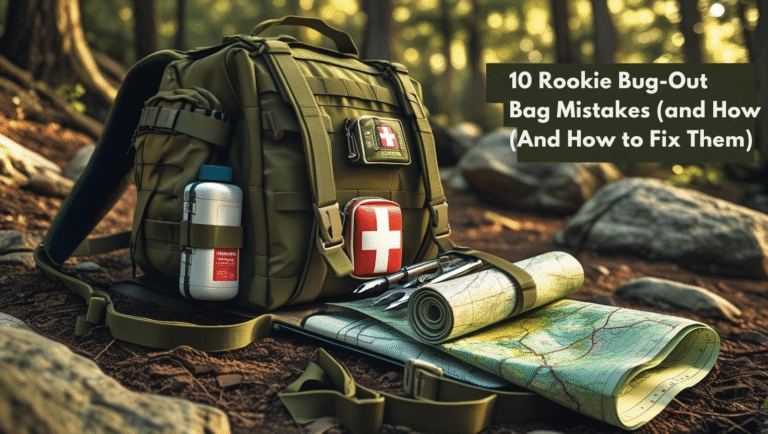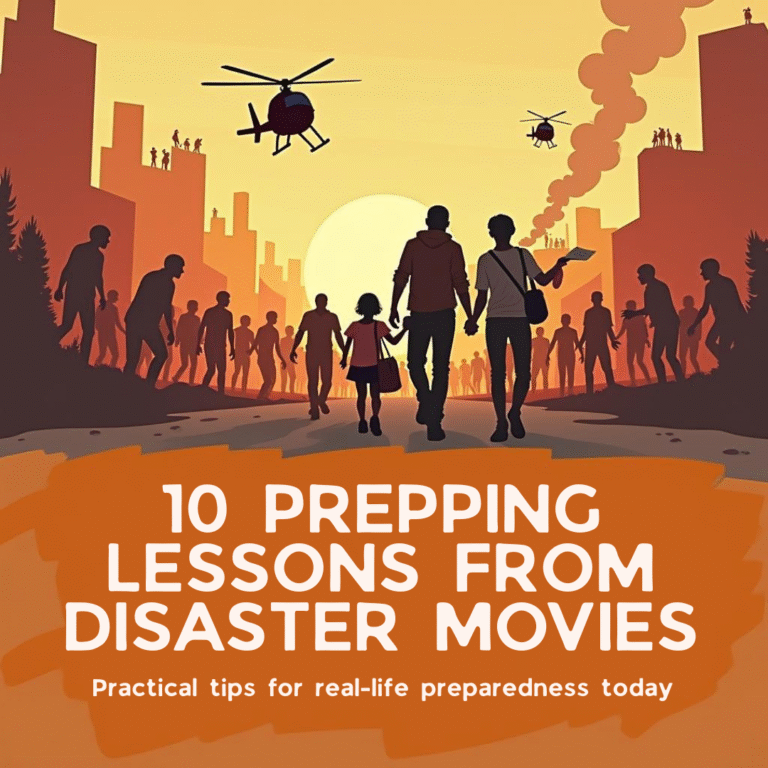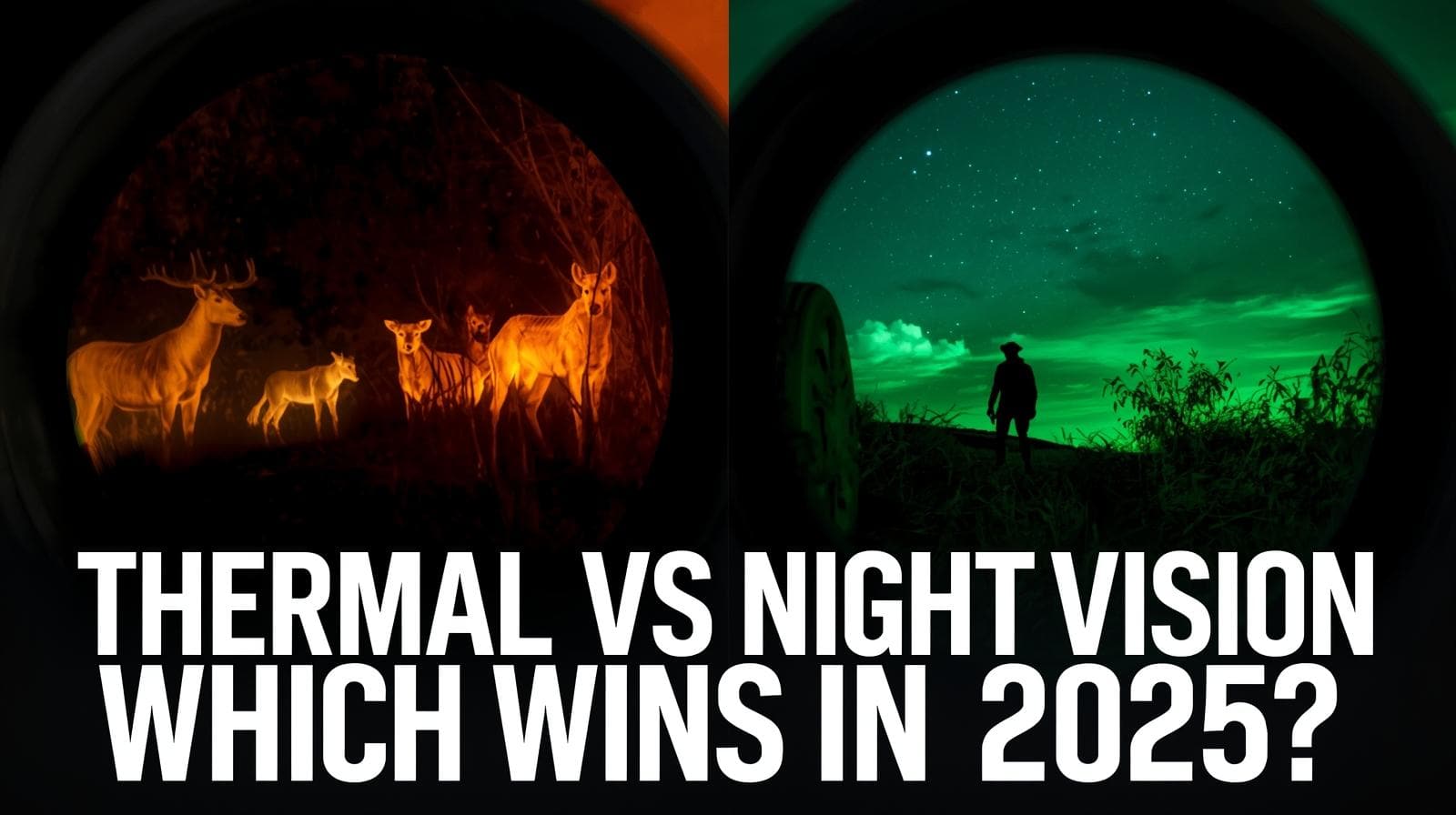
Thermal vs Night Vision: What’s Better for Preppers in 2025?
(Spoiler: It Depends on What You’re Trying to Survive)
Seeing in the Dark Isn’t Optional
When the grid dies and your flashlight screams “shoot me first,” there are only two kinds of people left: those who can see in the dark, and those who are the dark.
Preppers already know that night brings danger — but it also brings opportunity. Two technologies fight for your loyalty: thermal imaging and night vision. Both promise to keep you alive when everything else goes black, but each sees the world in a wildly different way.
The thermal vs night vision debate has raged in prepper circles for years, and for good reason. Your choice could mean the difference between detecting a threat at 300 yards or stumbling into it at 30 feet. Understanding the thermal vs night vision comparison isn’t just gear-nerd trivia — it’s survival intelligence.
You don’t need an engineering degree to choose wisely — you just need to know what problem you’re solving. Let’s break it down like a prepper who’s been on too many night patrols and too few coffee breaks.
What Is Thermal Imaging? (The Heat Seeker)
Thermal imaging doesn’t care about light. It detects heat signatures — anything that’s warmer (or cooler) than its surroundings. Living creatures, running engines, freshly-touched objects — they all glow like campfires on your display.
How Thermal Technology Actually Works
According to the National Institute of Standards and Technology, thermal imaging operates by detecting infrared radiation (heat) emitted by objects. Every object above absolute zero emits infrared energy, and thermal cameras use special sensors called microbolometers to convert this radiation into an electronic signal, which then gets processed into a visible image.
The result? A world rendered in gradients of heat, where warm objects appear bright and cool objects appear dark — regardless of visible light conditions.
When Thermal Dominates the Thermal vs Night Vision Battle
Field Note: Thermal wins when the air itself is against you — fog, smoke, total darkness. It cuts through the haze like a digital sixth sense.
The U.S. Department of Homeland Security has documented thermal imaging’s effectiveness in search and rescue operations during wildfires and natural disasters, where smoke and debris make traditional vision useless. For preppers facing SHTF scenarios involving urban fires, dust storms, or complete blackout conditions, this capability is invaluable.
Modern thermal devices can detect temperature differences as small as 0.1°F, according to research from FLIR Systems, one of the leading manufacturers in thermal technology. This means you can spot:
- Body heat through light foliage
- Recently driven vehicles (hot engines)
- Disturbed ground (thermal signature changes)
- Hidden individuals behind thin barriers
- Animals in complete darkness
Related Deep Dive: If you’re leaning thermal, check out [7 Best Thermal Scopes for Preppers in 2025] — my full field-tested lineup of scopes that don’t flinch when the power grid does.
What Is Night Vision? (The Light Amplifier)
Night vision doesn’t see heat; it amplifies ambient light. Moonlight, starlight, even distant street glow is boosted through a tube to paint the familiar green world we’ve all seen in movies.
The Science Behind Night Vision Technology
Traditional night vision operates through image intensification. According to the U.S. Army Night Vision and Electronic Sensors Directorate, photons of light enter through the objective lens, strike a photocathode that converts them to electrons, which are then multiplied thousands of times before striking a phosphor screen that converts them back into visible light.
The iconic green you see? That’s because the human eye can differentiate more shades of green than any other color, making it optimal for detail recognition.
Night Vision Generations: What You Need to Know
The thermal vs night vision choice gets more complex when you factor in night vision generations:
- Gen 1: Budget-friendly but limited range (75-100 yards), grainy image quality
- Gen 2: Significant improvement, 200+ yard range, better in low light
- Gen 3: Military-grade performance, 300+ yards, expensive ($2,000-$4,000)
- Gen 4 (Filmless): Technically doesn’t exist as an official designation, but refers to tube improvements
- Digital Night Vision: Uses digital sensors instead of tubes, more affordable, can record footage
The National Geospatial-Intelligence Agency notes that Gen 3 devices can amplify light 30,000-50,000 times, making them effective in near-total darkness conditions.
The Night Vision Trade-Off
The trade-off? It needs light — and that means in a moonless storm, you’re as blind as the rest of the neighborhood. But when there is light, the detail is sharp enough to tell friend from foe at distances where thermal only shows you heat blobs.
Skill Builder: If you already own a thermal scope, learn how to master it with [How to Use a Thermal Scope Like a Pro (Even If You’ve Never Touched One Before)] — because gear only works if the brain behind it does.
Thermal vs Night Vision — The Real-World Showdown
The thermal vs night vision debate isn’t about which technology is “better” — it’s about which solves your specific survival problems. Let’s break down each critical factor.
Detection Range & Target Clarity
Thermal Advantage: Detects heat hundreds of yards away — you’ll spot hogs or humans long before you can identify them. Research from the International Society for Optics and Photonics shows that quality thermal devices can detect human-sized heat signatures at 500+ yards in ideal conditions.
Night Vision Advantage: Lets you recognize what you’re looking at — is that a shovel or a shotgun? According to field testing data from Outdoor Life, Gen 3 night vision allows positive identification at 200-250 yards, significantly better than thermal’s blob-like rendering.
➡️ Prepper Math: Thermal = early detection. Night Vision = positive identification.
This distinction matters enormously. In a defensive scenario, detecting a potential threat at 400 yards gives you time to prepare, reposition, or avoid contact entirely. But misidentifying a neighbor as a threat because your thermal only shows heat could have catastrophic consequences.
Weather & Environmental Performance
The thermal vs night vision weather comparison isn’t even close:
Thermal laughs at:
- Fog, smoke, and pitch-black nights
- Rain and light precipitation
- Dust storms and airborne debris
- Complete absence of ambient light
Night Vision struggles with:
- Heavy fog (scatters available light)
- Smoke (blocks light photons)
- Complete darkness (nothing to amplify)
- Bright light sources (can damage tubes or cause blooming)
The National Oceanic and Atmospheric Administration has documented how particulate matter affects light transmission but has minimal impact on infrared radiation detection. When the air’s thick with chaos (wildfire smoke, dust storms, city blackouts), thermal is the hero.
However, as noted in Popular Mechanics testing, night vision excels in clear conditions with adequate starlight or moonlight, providing superior image quality for navigation and threat assessment.
Power Drain & Operational Weight
Thermal sensors chew through batteries faster than your cousin through your jerky stash. The microbolometer sensors and image processing require constant power. Expect 3-5 hours of continuous use per battery set in most consumer thermal devices.
Night Vision gear, being simpler, sips power and tends to weigh less — important when ounces become pounds and pounds become regret. Gen 3 tubes can run 20-40 hours on a single battery set.
According to specifications compiled by Gun Digest, a typical thermal monocular weighs 12-16 oz and requires frequent battery swaps, while comparable night vision devices weigh 9-12 oz and run significantly longer.
Prepper Reality Check: In a 72-hour bug-out scenario, night vision’s power efficiency could mean the difference between maintained situational awareness and a dead optic.
Price Point & Long-Term Durability
The thermal vs night vision cost analysis reveals significant differences:
| Feature | Thermal Imaging | Night Vision |
|---|---|---|
| Works in total darkness | ✅ Yes | ⚠️ Needs some ambient light |
| Cuts through fog / smoke | ✅ Yes | ❌ No |
| Detail / ID Clarity | ⚠️ Heat blobs only | ✅ Sharp image detail |
| Average Entry Cost | 💸💸💸 ($1,500 – $3,000) | 💸💸 ($800 – $2,000) |
| High-End Cost | 💸💸💸💸 ($5,000 – $15,000) | 💸💸💸 ($3,000 – $6,000) |
| Battery Life | ⚠️ 3-5 hours typical | ✅ 20-40 hours typical |
| Maintenance | Low (solid-state sensors) | Moderate (tubes can degrade) |
| Durability | Excellent (no tubes to break) | Good (tubes sensitive to shock/light) |
Data from OpticsPlanet shows that thermal prices have dropped 40% over the past five years as sensor technology improves, but they still command a premium over night vision.
Investment Perspective: According to The Prepared, a respected prepper resource, quality Gen 2+ night vision represents better value for most preppers, while thermal should be considered a specialized tool for specific scenarios.
Thermal vs Night Vision: Top Gear Recommendations
Best Thermal Pick: AGM Rattler TS35-384
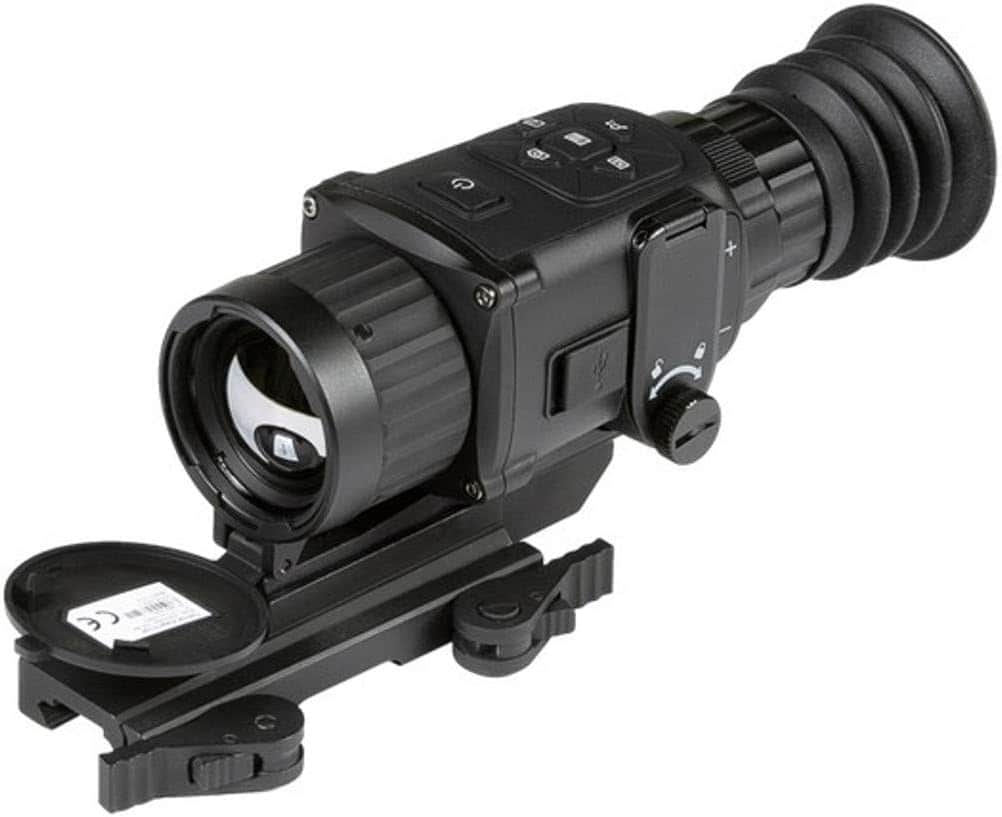
Why it wins the thermal vs night vision thermal category:
- 384×288 resolution sensor
- 1,475-yard detection range
- 12-hour battery life (exceptional for thermal)
- Rugged, military-grade housing
- Multiple reticle options
Real-World Performance: The Rattler has earned praise from Guns & Ammo for its crisp imaging and reliability in harsh conditions. The 35mm lens provides an ideal balance between field of view and detection range.
Price Point: ~$3,200-$3,800 (Check current price on Amazon or OpticsPlanet)
Best Night Vision Pick: ATN NVG7-2G Night Vision Goggles
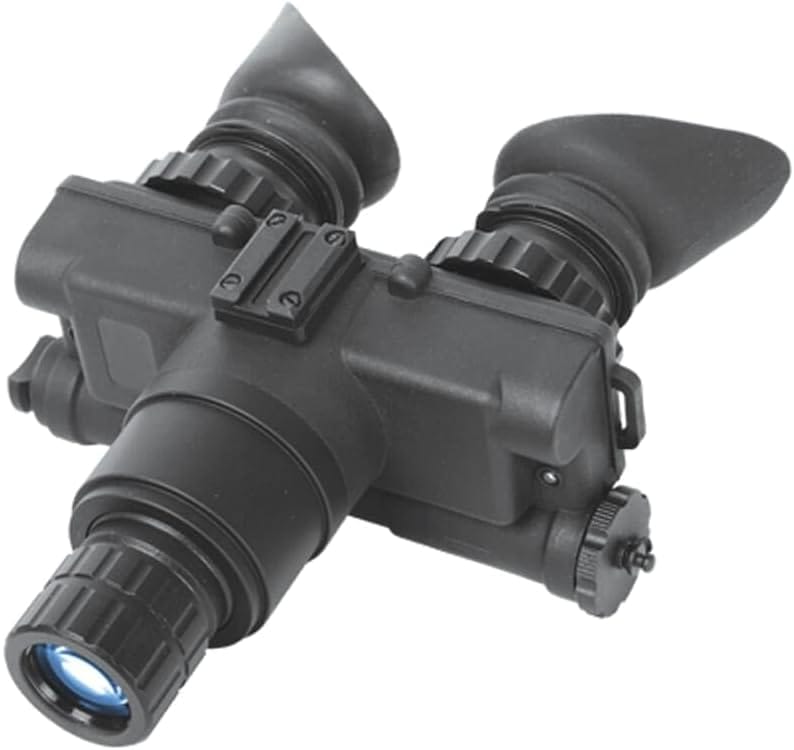
Why it wins the Thermal vs Night Vision category:
- Gen 2+ image intensifier tube with automatic brightness control
- Rugged, head-mounted hands-free design built for tactical and survival use
- Built-in IR illuminator for total darkness operation
- Weather-resistant polymer housing stands up to field abuse
- Long battery life (up to 50 hours on 2 AA batteries)
Real-World Performance:
The ATN NVG7-2G is a proven, no-nonsense goggle trusted by law enforcement and military personnel worldwide. Its balance of durability, clarity, and price makes it a prepper’s sweet spot between consumer gadgets and high-end Gen 3 tech. You’ll see crisp detail even in overcast, moonless nights — without babying fragile optics.
Price Point: ~ $2,000 – $2,300 (Check current price on OpticsPlanet or Amazon)
Premium Pick: Armasight PVS-14 Gen-3 Night Vision Monocular
Why it earns the premium slot for NV setups:
- Gen-3 image intensifier tube (white-phosphor options available for crisp contrast)
- Versatile mounting: handheld, head/helmet-mounted, or weapon-mounted with adapters
- Integrated IR illuminator for close-range detail in total darkness
- Robust, mil-spec-style construction built for field use and rough handling
- Manual gain/brightness control for real-world tuning in variable conditions
Real-World Performance:
The PVS-14 family is a field-proven workhorse used by professionals and serious users — excellent image clarity, modular accessory ecosystem (3×/6× afocal lenses, mounts, IRs), and configurable options (Bravo → Pinnacle → Pinnacle Elite) that scale performance for the money. It’s a standard go-to when you want true Gen-3 performance without chasing boutique military-only kit. Armasight+1
Price Point: ~ $5,999 – $8,499 depending on tube spec (Bravo → Pinnacle → Elite) and kit options (lenses, mounts, bundled IR). Availability is solid through U.S. dealers (Armasight shop, Primary Arms, Amazon).
Thermal vs Night Vision: Which Is Better for Different Prepper Scenarios?
The thermal vs night vision question can only be answered by examining your specific needs:
Urban Survival & Home Security
Winner: Thermal (70/30 advantage)
Thermal sees body heat through brush or thin barriers — perfect for spotting looters skulking behind fences or cars. In urban environments with ambient light pollution, you don’t need night vision’s amplification capabilities as much.
According to research from Security Magazine, thermal cameras have become the preferred technology for perimeter security because they can detect intrusions in complete darkness and through light obscurants like chain-link fences.
Tactical Advantage: You’ll spot someone approaching your property long before they spot you, giving you time to challenge, hide, or prepare a defensive position.
When night vision is better: If you need to identify whether the person approaching is a known neighbor or stranger, night vision’s detail becomes critical. Many preppers run thermal for detection, then switch to NV for positive ID.
Rural Property & Homestead Defense
Winner: Night Vision (60/40 advantage)
Night vision helps you identify targets before acting. You’ll know if that glowing blob is a coyote, your neighbor, or your kid sneaking out. On rural property where detection ranges exceed urban scenarios and you need to identify livestock, vehicles, and people, night vision’s clarity wins.
Case Study: Modern Farmer documented a homesteader who prevented three false-alarm shootings in one year by using night vision to confirm that detected movement was actually their own livestock, not predators or intruders.
Thermal Still Has Value: Use thermal for quick scans to detect any heat signatures, then switch to NV for detailed observation. This dual approach is ideal for large properties.
Hunting & Scouting Game
Winner: Context-Dependent (50/50 split)
The thermal vs night vision hunting debate depends entirely on your quarry and environment:
Thermal gives you the edge for:
- Finding game in thick cover and brush
- Detecting animals bedded down in tall grass
- Hog hunting in total darkness
- Tracking wounded game by blood trail heat signatures
The Quality Deer Management Association notes that thermal imaging has revolutionized predator control and invasive species management, allowing hunters to detect animals that would be impossible to spot with night vision.
Night vision shines when:
- Tracking or moving quietly through woods without blinding yourself
- Hunting in open terrain with good starlight
- Identifying shot placement and tracking
- Navigating complex terrain without falling
Legal Note: Always check your state’s hunting regulations. According to the National Deer Association, many states restrict or prohibit the use of night vision or thermal imaging for hunting certain game species.
Bug-Out & Long-Distance Movement
Winner: Night Vision (70/30 advantage)
When you’re covering ground in darkness, night vision’s superior battery life, lighter weight, and navigational clarity make it the better choice. You need to see terrain features, obstacles, and potential hazards — not just heat signatures.
Field Experience: The Gray Bearded Green Beret (a respected survival instructor) advocates for night vision as the primary bug-out optic because “you navigate with your feet, not your scope.”
Thermal’s Role: A handheld thermal monocular for periodic scanning can detect ambushes or animals before you walk into them, but shouldn’t be your primary navigation device.
Search & Rescue / Medical Emergency Response
Winner: Thermal (90/10 advantage)
When someone is lost, injured, or hiding, thermal imaging cuts search time dramatically. According to data from FEMA’s Urban Search and Rescue program, thermal imaging can reduce search times by 60-80% compared to traditional methods.
Critical Capability: Thermal can detect body heat through light building materials, overturned vehicles, and debris — life-saving in disaster scenarios.
The Balanced Loadout: Why Not Both?
If budget allows, the thermal vs night vision debate has a simple solution: run both.
The Two-Tool Approach:
- Use thermal for scanning and detecting threats — quick, wide-area sweeps to identify heat signatures
- Switch to night vision for positive ID and navigation — detailed observation and movement
“Personally, I’d grab a thermal first. You can’t shoot what you can’t see,” says former Navy SEAL and survival instructor Clint Emerson, author of “100 Deadly Skills.“
Budget Priority: If you can only afford one, consider your primary threat model:
- High threat density (urban/suburban): Thermal for detection
- Low threat density (rural/wilderness): Night vision for identification and movement
Then, when funds recover, pick up the complementary technology to round out your kit.
Practical Tips for Real-World Thermal vs Night Vision Use

Optimize Your Night Vision Setup
Pair with IR Illuminators: For night vision, an IR flashlight is like flipping on a secret spotlight only your goggles can see. The SureFire Vampire series offers both white light and IR in one package.
According to Breach Bang Clear, quality IR illuminators can extend your effective night vision range by 100+ yards in low-light conditions.
Mount Smart for Your Mission:
- Head-mounted: Best for mobility and hands-free operation
- Weapon-mounted: Ideal for hunting and defensive applications
- Handheld: Perfect for scouting and observation
Maximize Your Thermal Performance
Understand Thermal Limitations: Thermal can’t see through glass (it reflects thermal radiation) or water. As documented by FLIR’s training materials, thermal imaging is blocked by standard window glass, which is why it’s ineffective for vehicle surveillance through windows.
Optimize Detection Distance: Use higher magnification for detection at distance, then zoom out for situational awareness once threats are located.
Universal Best Practices for Both Technologies
Train in Darkness: Technology can fail; muscle memory can’t. According to Presscheck Consulting, experts recommend spending at least 20% of your training time in darkness to build competence.
Protect the Lenses: Thermal sensors and NV tubes hate direct sunlight; use lens caps religiously. Gen 3 night vision tubes can be permanently damaged by exposure to bright light sources, as warned by manufacturers and documented by Night Vision Guys.
Rotate Batteries Monthly: A dead optic is a $3,000 paperweight. Use a battery rotation system and keep spares in sealed, cool storage.
Weather-Proof Your Gear: Even “waterproof” optics should be protected. Use protective covers and cases rated for your environment.
Document Your Settings: Keep a log of optimal settings for different conditions (urban/rural, weather, distance). This knowledge base is invaluable during actual emergencies.
The Future of Thermal vs Night Vision Technology
The thermal vs night vision landscape is evolving rapidly:
Digital Fusion Technology
Emerging devices from companies like Pulsar and ATN are combining thermal and digital night vision in single units. These fusion devices overlay thermal heat signatures onto night vision images, giving you the best of both worlds.
According to Military Embedded Systems, the U.S. military is investing heavily in fusion technology for next-generation targeting systems.
Improved Battery Technology
New lithium battery chemistries promise 50% longer runtime at similar weights. This could make thermal’s battery drain less of a disadvantage in the thermal vs night vision equation.
Decreased Thermal Pricing
As sensor manufacturing improves, thermal devices that cost $5,000 in 2020 now sell for $2,500-$3,000. This trend is expected to continue, making thermal more accessible to average preppers.
AI-Enhanced Detection
Some manufacturers are integrating AI algorithms that can automatically identify and classify targets (human, animal, vehicle) in both thermal and night vision devices. While still in early stages, this could revolutionize threat assessment.
Key Takeaways: Winning the Thermal vs Night Vision Debate
Let’s crystalize the thermal vs night vision comparison into actionable intelligence:
Choose Thermal Imaging When:
- You need detection in any weather condition
- Fog, smoke, or complete darkness are common in your AO (area of operations)
- Early warning of heat signatures is your priority
- You can manage shorter battery life
- Budget allows for premium technology
Choose Night Vision When:
- Target identification and detail are critical
- You need extended battery life for long operations
- Navigation and terrain assessment are priorities
- You want better value per dollar spent
- Clear weather is typical in your region
Choose Both Technologies When:
- You’re serious about comprehensive night capability
- Budget allows for layered systems
- Your threat model includes multiple scenarios
- You want detection (thermal) AND identification (night vision)
The Bottom Line: Thermal finds the threat, night vision confirms it, and both keep you alive to complain about the price later.
Thermal vs Night Vision: Final Comparison Matrix
Here’s your quick-reference guide for the thermal vs night vision decision:
| Scenario | Thermal | Night Vision | Winner |
|---|---|---|---|
| Total darkness detection | Excellent | Poor to Moderate | Thermal |
| Fog/smoke/dust | Excellent | Poor | Thermal |
| Target identification | Poor | Excellent | Night Vision |
| Battery life | 3-5 hours | 20-40 hours | Night Vision |
| Weight | Moderate | Light to Moderate | Night Vision |
| Initial cost | $1,500-$15,000 | $800-$6,000 | Night Vision |
| Maintenance | Low | Moderate | Thermal |
| Learning curve | Moderate | Easy to Moderate | Night Vision |
| Urban security | Excellent | Good | Thermal |
| Rural navigation | Good | Excellent | Night Vision |
| Hunting detection | Excellent | Good | Thermal |
| Hunting identification | Poor | Excellent | Night Vision |
Wrapping Up: Your Next Steps in the Thermal vs Night Vision Journey
The thermal vs night vision debate isn’t about declaring a universal winner — it’s about matching capability to mission. Both technologies have carved out essential roles in modern preparedness.
If you’re ready to commit to the dark-side (literally), here’s your action plan:
Start with Detection
Begin with 7 Best Thermal Scopes for Preppers in 2025 to find gear that won’t quit when you need it most. This comprehensive guide breaks down field-tested units across every price point.
Master Your Equipment
Then learn How to Use a Thermal Scope Like a Pro (Even If You’ve Never Touched One Before) so your new toy doesn’t turn into expensive confusion. Knowing which buttons to push in the daylight means nothing if you can’t operate it smoothly in pitch darkness with gloves on.
Round Out Your Capability
Coming soon: [Best Night Vision Goggles for Preppers in 2025] — bookmark it to complete your night vision stack and address the identification gap that thermal leaves behind.
Continue Your Education
For deeper dives into preparedness and tactical gear, check these authoritative resources:
- The Prepared — Evidence-based prepping guides
- ITS Tactical — Skills and gear from former military professionals
- Primary & Secondary — High-end tactical equipment reviews
- TNVC (Tactical Night Vision Company) — Industry-leading night vision resource
Final Wisdom on Thermal vs Night Vision
Understanding the thermal vs night vision equation is just the beginning. The real capability comes from training, practice, and knowing your equipment so well that it becomes an extension of your senses rather than a gadget you’re fumbling with in the dark.
Because when the lights go out, the last thing you want to be is surprised. Whether you choose thermal, night vision, or both, make the decision now, train with it regularly, and integrate it into your overall preparedness strategy.
The darkness doesn’t care about your excuses. But it does respect preparation.
Disclaimer: This content is for informational purposes only. Always follow local laws and regulations regarding night vision and thermal imaging devices. Some jurisdictions restrict possession or use of these technologies.
Transparency Notice: This article contains affiliate links to products we genuinely recommend. When you purchase through these links, we earn a small commission that helps support our testing and content creation—enough to keep our gear reviews honest and our emergency food supplies stocked. We only recommend knives we’ve personally tested or that come highly recommended by trusted survival professionals. Your trust matters more than commissions.

